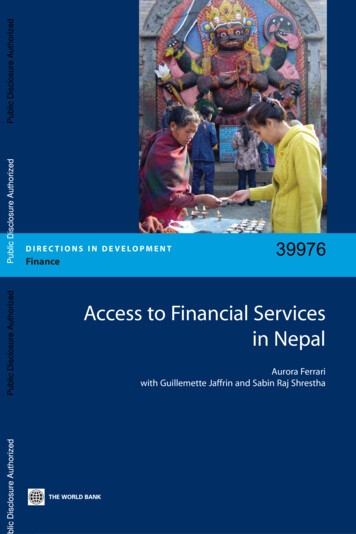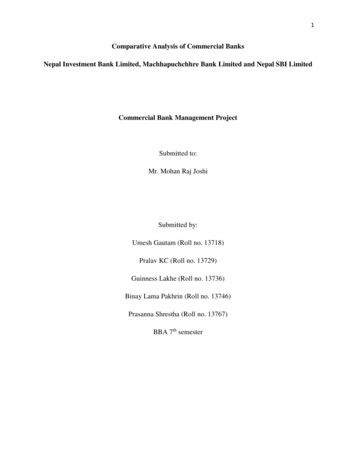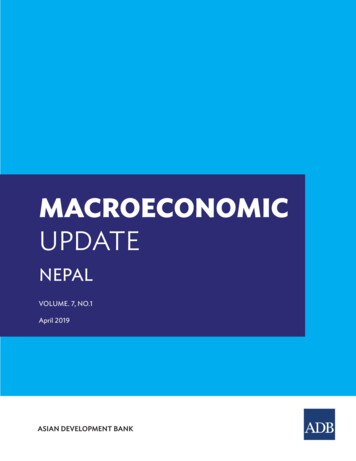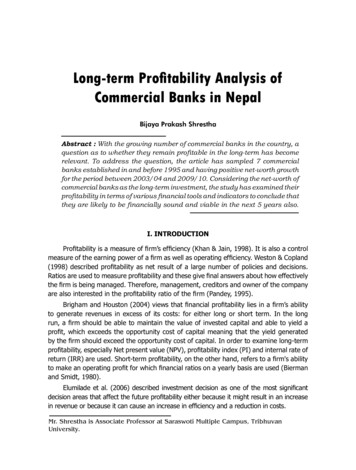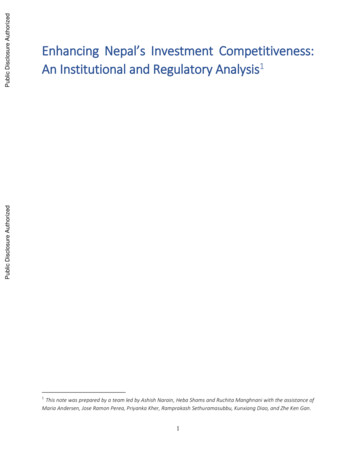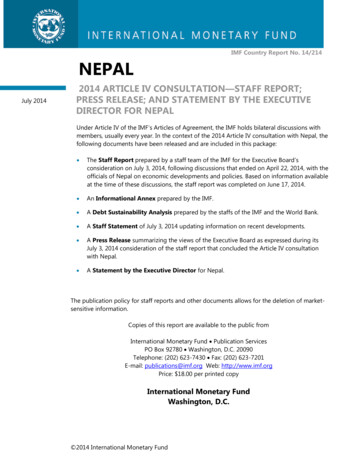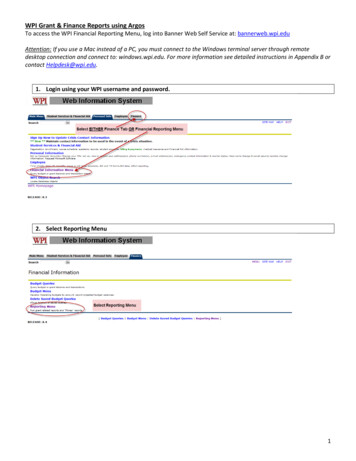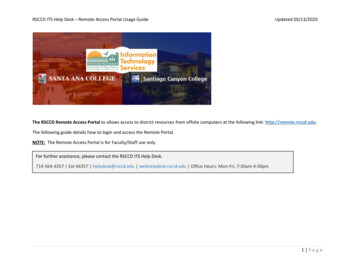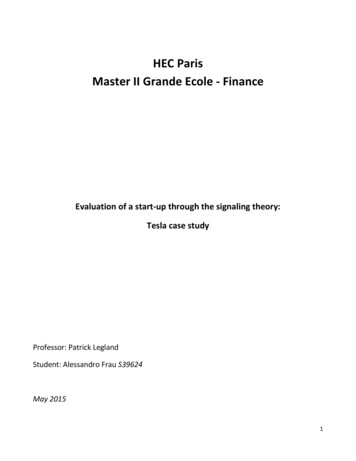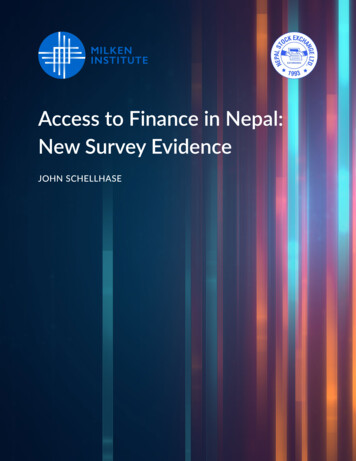
Transcription
Access to Finance in Nepal:New Survey EvidenceJOHN SCHELLHASE
MILKEN INSTITUTEACCESS TO FINANCE IN NEPALII
ABOUT THE MILKEN INSTITUTEThe Milken Institute is a nonprofit, nonpartisan think tank.For the past three decades, the Milken Institute has served as a catalyst forpractical, scalable solutions to global challenges by connecting human, financial, andeducational resources to those who need them. Guided by a conviction that thebest ideas, under-resourced, cannot succeed, we conduct research and analysis andconvene top experts, innovators, and influencers from different backgrounds andcompeting viewpoints. We leverage this expertise and insight to construct programsand policy initiatives.These activities are designed to help people build meaningful lives in whichthey can experience health and well-being, pursue effective education andgainful employment, and access the resources required to create ever-expandingopportunities for themselves and their broader communities.ABOUT THE GLOBAL MARKET DEVELOPMENT PRACTICEThe Milken Institute’s Global Market Development practice works to catalyzeprivate-sector-led growth and economic prosperity in developing countries andemerging markets. The practice pursues this mission by facilitating informed andcoordinated policymaking processes across government institutions, private-sectorstakeholders, and civil society, and by training a generation of leaders in centralbanks, finance ministries, and securities regulators, among other financial institutions.ABOUT THE NEPAL STOCK EXCHANGEThe Nepal Stock Exchange (NEPSE) contributes to the creation of wealth in Nepalthrough providing a platform for the trading of listed securities, as well as clearingand settlement facilities, and supervising and regulating its members. The basicobjectives of the NEPSE are to provide liquidity for government bonds and corporatesecurities by facilitating transactions through intermediaries, such as brokers andmarket makers, and to protect investors’ rights. 2019 Milken InstituteThis work is made available under the terms of the Creative CommonsAttributionNonCommercialNoDerivs 3.0 Unported License, available N INSTITUTEACCESS TO FINANCE IN NEPAL1
Introduction andSummary of FindingsIn late May 2019, the Nepal Stock Exchange (NEPSE) hostedthe annual meeting of the executive committee of the SouthAsian Federation of Exchanges (SAFE), an association of stockexchanges that promotes the development of the region’ssecurities markets. As part of the meeting, the NEPSE andSAFE partnered with the Milken Institute to hold a roundtablecovering various aspects of modernizing Nepal’s equity markets,including the foundations for capital market development,attracting new listings and new investors, improving the tradingenvironment, and the ownership and governance structures ofthe NEPSE.1To inform the roundtable discussion, NEPSE and the Milken Institute conducted asurvey earlier that month of Nepali businesses. Its purpose was to provide timelydata on the current business environment and to better understand firms’ concernsabout access to finance and risk exposure and their thoughts on developing thestock market. In this report, we present the results of the survey pertaining to thebusiness environment, access to finance, and demand for new financial tools andfunding sources. A subsequent paper will discuss findings specific to equity marketdevelopment.Access to finance and related issues are integral to the government’s economicdevelopment agenda. As the World Bank notes in a 2018 report on Nepal, “Improvedaccess to finance, improved intermediation, and the development of long-termfinance will be crucially important to channel finance (foreign or local) to productiveactivities.”2 Accordingly, it is important to learn from Nepali firms themselves howthey rank financial access among other obstacles to growth, their current fundingsources and those they wish they could access, the consequences they report dueto a lack of funding, their exposure to risks, and the kinds of financial products theywould like to see developed.1 . For a summary of the roundtable discussion, see “Framing the Issues: Modernizing the Public Equity Market in Nepal”(Milken Institute, November 2019), modernizing-public-equitymarket-nepal.2“Nepal Development Update: Maximizing Finance for Development” (World Bank, November 2018), ance-forDevelopment.MILKEN INSTITUTEACCESS TO FINANCE IN NEPAL2
The NEPSE-Milken Institute survey examined these questions directly. Seven keyfindings emerged from the results. They are summarized here and explored in greaterdetail in the following pages.1. COMPANIES RANK ACCESS TO FINANCE AS THEIR TOP OBSTACLE:Among responding firms, 25 percent said access to finance was the numberone obstacle in a list of 17 options.2. CONCERNS ABOUT POLITICAL INSTABILITY AND ACCESS TOELECTRICITY HAVE NEARLY VANISHED: In a dramatic shift from a 2013World Bank Enterprise Survey in which political instability and access toelectricity ranked as the top two business obstacles,3 just 6 percent ofresponding firms in 2019 cited political instability as their greatest obstacle,and none cited electricity as a top concern.3. ACCESS TO FINANCE AS A BUSINESS OBSTACLE DOES NOT APPEARTO MEAN AN INABILITY TO ACCESS BANK LENDING: Only 10 percentof responding firms said they could not access bank loans. Even amongsmall and medium-sized enterprises (SMEs), only 14 percent of respondentssaid they wanted to use bank lending but lacked access.4. BANK LOANS AND OTHER CURRENT FUNDING SOURCES AREGENERALLY INSUFFICIENT FOR GROWTH: Difficulty raising fundslimited firms’ ability to expand operations, according to 59 percent ofrespondents, while 42 percent said that a lack of finance limited theirability to invest in R&D. Few firms reported extreme consequences, such ashaving to close branches or lay off employees.5. A LARGE MAJORITY OF FIRMS ARE EXPOSED TO INTEREST RATEFLUCTUATIONS: About 75 percent of all responding firms—including 90percent of firms that currently use bank loans as a funding source—saidthat interest rate changes expose them to financial risk.6. MOST FIRMS WOULD USE DERIVATIVES IF THESE PRODUCTS WEREAVAILABLE: Over 80 percent of reporting firms said they would usefinancial derivatives to help manage their exposure to interest rate, foreignexchange, and commodity price risks.7. DEMAND IS ALSO STRONG FOR NEW CORPORATE FINANCINGSOURCES, PARTICULARLY FDI: Nearly 60 percent of surveyed firms saidthey wanted access to foreign direct investment (FDI). The survey resultsalso found an appetite among a sizable percentage of firms for financingthrough private equity, invoice factoring, and debt issuance.3. World Bank “Enterprise Surveys” data for Nepal (World Bank, 2013), conomies/2013/nepal.MILKEN INSTITUTEACCESS TO FINANCE IN NEPAL3
The report proceeds with a general description of the survey methodology and thesample of respondents, followed by a discussion of the survey’s potential limitations.A subsequent section provides a broader discussion of the key findings. A concludingsummary addresses the implications for Nepal’s broader economic developmentagenda.The report concludes with a summary of the main themes discussed by roundtableparticipants and a detailed table of the concrete recommendations that emergedfrom the discussion.Methodology, SampleDescription, and LimitationsThe NEPSE-Milken Institute survey was conducted from May 2 24, 2019, by meansof a Survey Monkey click-through survey, the link to which was emailed to membersof various Nepali business associations, and by in-person interviews conducted byNEPSE staff. All questions were posed in English. Some questions used and builton language from the World Bank Enterprise Surveys.4 The survey team focused oncollecting responses from both SMEs and large firms in five priority sectors identifiedby the International Finance Corporation (IFC)—tourism, agribusiness, health, ITservices, and education5—but welcomed responses from other sectors. Respondentswere proprietors, senior-level executives, or staff with direct knowledge of the firm’sfunding sources and ownership structure.FigureFirms,by SizeFigure1:1:PercentagePercentage ofofFirms,by Size(a) Firm size by number of employees(b) Firm size by value of fixed Large30%40%50%Small50%010%20%30%40%50%Source: NEPSE-Milken Ins tute Survey of Nepali Businesses, 20194. The survey’s question about top business obstacles included the 15 obstacles cited by the World Bank in its 2009 and2013 Nepal Enterprise Surveys and added two more—lack of policy clarity and ambiguity of the new federal structure—to reflect potential new concerns following the adoption of the 2015 constitution.5. “Creating Markets in Nepal: Country Private Sector Diagnostic” (World Bank, October 2018), f-fc13920f89dd/CPSD Nepal Oct18 2 Web.pdf?MOD AJPERES&CVID msllQer.MILKEN INSTITUTEACCESS TO FINANCE IN NEPAL4
During the collection period, the survey team received 126 valid survey responses,most of which were collected online. Figure 1 breaks down the sample by firm size,based on two assessments: an international, employment-based definition as wellas Nepal’s asset-based definition.6 By either definition, SMEs constituted about 70percent of the sample, and large firms make up the remaining 30 percent. Figure 2shows the range of sectors represented in the sample. About half the surveyed firmswere in the financial services, manufacturing, tourism and hospitality, or agribusinessand forestry sectors.The survey has several limitations. First, it was conducted to inform a roundtablediscussion and provide a general overview for participants, not a comprehensivedescription of the business environment. We recognize the sample of 126 firms isnot statistically significant as a representation of the national business community.Second, it was conducted in English and primarily online. As a result, firms whoseproprietors or managers did not speak English were excluded from the sample,while firms without Internet access had little opportunity to participate. Third, thefinancial services industry is over-represented in the sample due to the focus onFigure2: 2:Percentageof Firms,by SectorFigurePercentageof Firms,by SectorFinancial services17%16%Manufacturing11%Tourism and HospitalityAgribusiness and Forestry9%8%Other7%Communica ons and Marke ngTrading6%Legal Services or Consul ng6%ICT services6%Automobile industry4%3%Educa on2%Energy2%HealthConstruc on2%Source: NEPSE-Milken Ins tute Survey of Nepali Businesses, 2019.Note: Here and elsewhere, percentages may not add up to 100 due to rounding.6 . The World Bank classifies firms with fewer than 20 employees as small, those with 20 99 employees as medium, andfirms with 100 or more employees as large. In Nepal, the Industrial Policy of 2010 issued by the Ministry of Industry,Commerce and Supplies defines small-scale industries as having fixed assets valued at up to 50 million Nepali rupees(NPR); medium-scale industries as having between NPR 50 million and NPR 150 million in fixed assets; and large-scaleindustries as having fixed assets valued at more than NPR 150 million.MILKEN INSTITUTEACCESS TO FINANCE IN NEPAL5
collecting responses from companies listed on the Nepal Stock Exchange. Fourth,106 respondents (84 percent of the sample) were located in the Kathmandu Valley(Province 3), while only 20 firms (16 percent) were from other provinces.7Thus, the survey results are more representative of conditions in the capital city andsurroundings, and less indicative of challenges that rural businesses face. Finally,there may be response biases associated with face-to-face interviews conducted byNEPSE staff members.Despite these limitations, the survey is the first formal effort since 2013 to collectevidence from private-sector firms on the business environment and their ability toaccess finance.8 While the findings should be interpreted cautiously, they constitutea potentially valuable source of information for policymakers and developmentpartners. They may also serve as a useful compass for more expansive researchefforts on these topics. To that end, a data appendix at the end of the paper presentsraw findings in a series of tables.Survey Findings and AnalysisThe chief findings presented here fall under three maincategories: the business environment, access to finance, andthe demand for new financial products and funding sources.A discussion of each follows.THE BUSINESS ENVIRONMENTFINDING: COMPANIES RANK ACCESS TO FINANCE AS THEIR TOP OBSTACLE.Survey participants were given a list of 17 possible business obstacles—adapted fromthe World Bank Enterprise Surveys—and were asked to select which was the “topobstacle” currently facing their business. Selected by 25 percent of firms, access tofinance ranked as the greatest obstacle facing survey respondents. And two-thirds(65 percent) reported access to finance to be either a moderate, major, or very severeobstacle.Dividing the sample by firm size and sector reveals some interesting nuances to thisfinding—nuances that suggest policy initiatives to catalyze economic growth shouldbe tailored for challenges specific to firm size and sector.7. There were no responses from the two westernmost provinces, one of which, Sudurpashchim Pradesh, is home tonearly 10 percent of the population.8. As far as we know, the last formal attempt to gather survey-based data from Nepali firms on their businessenvironment was the 2013 World Bank Enterprise Survey.MILKEN INSTITUTEACCESS TO FINANCE IN NEPAL6
Figure 3: Top BusinessFigureObstaclesin Nepal(by percentof(byrespondents)3. To
5. A LARGE MAJORITY OF FIRMS ARE EXPOSED TO INTEREST RATE FLUCTUATIONS: About 75 percent of all responding firms—including 90 percent of firms that currently use bank loans as a funding source—said that interest rate changes expose them to financial risk. 6. MOST FIRMS WOULD USE DERIVATIVES IF THESE PRODUCTS WERE
